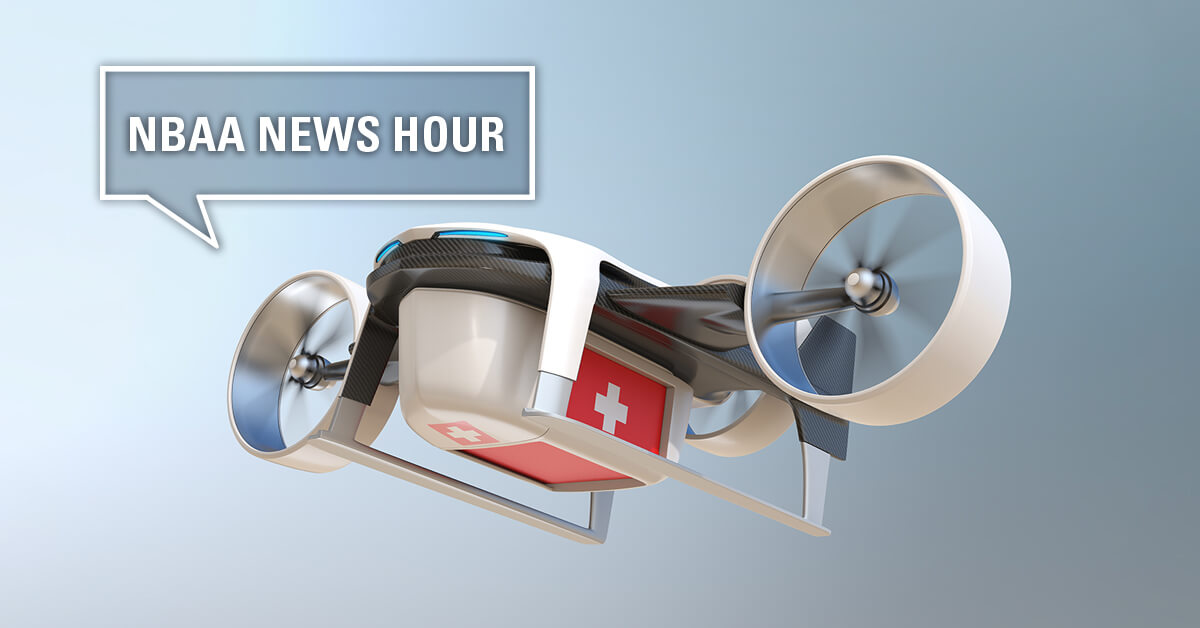
Aug. 3, 2020
The potential of electronic vertical takeoff and landing (eVTOL) aircraft is boundless and has stimulated a necessary debate on urban air mobility (UAM). But, as the July 31 NBAA News Hour moderated by NBAA Director, Air Traffic Services and Infrastructure Heidi Williams discussed, the first eVTOLs to be introduced to our daily lives will likely be as tools to aid first responders attending medical emergencies.
“Research shows that there are 3.4 million time-critical emergencies each year in the United States and with these events survival is directly correlated with the amount of time it takes to receive first aid. Even very minor intervention is extremely impactful,” explained Katerina Barilov, co-founder and head of business development at Jump Aero Incorporated, a company that is developing a single-seater eVTOL for first responders. “Nationally, an ambulance takes on average eight minutes to reach an emergency but with the eVTOL technology that we can foresee being available in terms of batteries and software we can cut that time in half.”
This direct and tangible public benefit will fuel the medical field’s role as an early adopter of eVTOL technology, noted Yolanka Wulff, co-executive director of Community Air Mobility Initiative, an advocacy group that provides education and resources to the public, decision-makers and the media about the development and implementation of UAM.
“The biggest barrier to the rollout of UAM is public acceptance and acceptance starts with understanding,” said Wulff. “As a first responder application, eVTOL will not require the complex infrastructure that a public transportation system will require, and there is a clear public benefit that makes the barrier to acceptance far lower than it is for the idea of flying limousines or on-demand air taxis.”
Simplicity also is key to the deployment of eVTOL as a first responder technology, said Barilov. Using eVTOL solely as a method to transport medical personnel to an emergency should ease concerns held by the public and regulators over the commercial application of eVTOL, while the medical profession, particularly in rural communities across America, will realize the cost-benefit of a tool that requires much less effort to operate than a helicopter while providing the immediacy of a road vehicle.
“Not only can we save lives, we could potentially save money by also preventing treatment and hospitalizations,” Barilov added.
First responders are enthusiastic about the potential impact of eVTOL on emergency preparedness, said Barilov, noting that she has been “pleasantly surprised” by the interest from first responders and the number of first responders – particularly in fire departments – who hold a current pilots license or are interested in becoming a pilot.
While the first generation of commercial eVTOL may take a decade to be operational, first responder applications could be with us much sooner, said Peter Shannon, founder and managing director of Radius Capital, a venture capital firm that specializes in advanced aerial mobility.
But while the direct transportation mission of first responder-eVTOL assuages the infrastructure concerns of a broader application of the technology, the fact that first responders will have to land anywhere rather than a designated location introduces its own issues.
“The first responder mission itself is diverse and depending on the situation could encompass complexities that extend beyond the basic air mobility of a routine eVTOL flight,” said Shannon. This complexity is compounded by the FAA’s decision to regulate eVTOL under FAR Part 135 as well as the current approach to regulating and designating visual and instrument flight rules, he added.
And then there is the weather. The introduction and growth of UAM is premised on advances in gathering and disseminating weather data, especially when considering automated operations, but Shannon also noted that the size of proposed eVTOL aircraft makes them more susceptible to weather than other aircraft types. “There is a question on what gaps exist between the technologies for increasing the resilience of vehicles flight in different weather conditions,” he said.
The panelists unanimously agreed that redesigning the current national airspace architecture to accommodate UAM aircraft will be more challenging than certifying this new family of aircraft, however, the unique demands that will be placed on UAM aircraft will require a fresh and localized approach to certification.
“This is where an organization like NBAA, with its regional and local offices, really comes into play,” said Wulff. “We will need that local expertise as we roll out UAM because it is going to be different in every location. What works for Seattle is different than the needs of Los Angeles, Washington or Fargo, ND. It’s going to be very tailored so everything on the ground is going to depend on those local connections and experts.”


 International Business Aviation Council Ltd.
International Business Aviation Council Ltd.